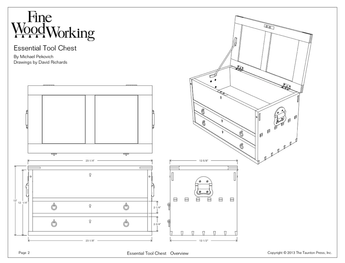Discussion Forum
Get It All!
UNLIMITED Membership is like taking a master class in woodworking for less than $10 a month.
Start Your Free TrialCategories
Discussion Forum
Digital Plans Library
Member exclusive! – Plans for everyone – from beginners to experts – right at your fingertips.
Highlights
-
Shape Your Skills
when you sign up for our emails
This site is protected by reCAPTCHA and the Google Privacy Policy and Terms of Service apply. -
 Shop Talk Live Podcast
Shop Talk Live Podcast -
 Our favorite articles and videos
Our favorite articles and videos -
E-Learning Courses from Fine Woodworking
-
-
 Fine Woodworking New England Event
Fine Woodworking New England Event -














Replies
Nope, won't open for me.
Look at my latest update for photos
Possibly beech.
Thank you!
Tenderfoot Bob
Looks like white oak.
Picture from my white oak floor.
There they are! Agre with chi.
Acacia -- I have a whole stack of rounds that looks just like that.
A strong possibility. Thank you?
Perhaps.
What does the end grain section look like?
“[Deleted]”
Tanoak. Notholithocarpus densifloris.
It has that same interlocking, fine grain that beech has, but the dark, splotchy color is not consistent with most beech I have seen.
The end grain often holds the most clues. You can use Bruce Hoadley's (or other book on wood ID) to narrow it down.
That makes sense, Rclark. Beech doesn't naturalize in California with the lack of summer rains. If it was Beech, and grew in California, it would have been in a landscape somewhere. Tanoak is native to coastal CA, and in parts of the Northern Sierra foothills. Tanoak is not a true oak, but is still in Fagaceae, along with Beech, and, as best as I can tell, systematically lies somewhere between Quercus (Oak) and Fagus (Beech). I cut and use a lot of Tanoak, but don't have any experience with Beech, and have often wondered how similar Tanoak and Beech are...Could also be one of the oaks, of which there are many in CA, though few of them grow straight.
attached is a desk from tan oak, pre-finish.
Oak of some sort. Certainly not beech. Kind of doubt its white, or at least the quercus alba white oak. Looks a lot like the California black oak I have from the Yosemite area.
This looks like a picture of the tangent plane... do you have a piece of the radial plane, or the end grain?
Hmmm, here are are some mallets from Q. chrysolepis, Canyon Oak, also known as Maul Oak and Goldencup Oak, another CA native. I don't know the wood of Black Oak, but that also seems plausible...
Alright, I officially retract the guess of Tanoak. Per Jbailey, I like his call of Black Oak, but I also just shot another pic of Canyon Oak, which looks really close, and also occurs in the foothills of the Sierra.
It is wood.
The species cannot be determined reliably from the information given.
If you give more information about provenance, location, density, odour, end grain images etc you might get lucky, but pics without more information are just too difficult to give more than a guess.
FWIIW it is most likely oak. It may be beech. It's not impossible that it is rewarewa, though that is unlikely. I am sure there are many other options.
A sort of a test for oak is to see if it goes black when exposed to iron (you can make iron acetate with vinegar and steel wool) but this is not a reliable excluder unless the wood is still wet. Oak, Cherry and Walnut can be blackened with iron and it's very unlikely indeed to be the latter two.
End grain imagery is very useful.
Here’s a little box I made from some white oak I had. It looks similar.
“[Deleted]”
Here are a few of the White Oak species that would be in a pile of white oak logs at the sawmill In North America. You will need a leaf and some bark from the tree to tell what species it is.
If you put a piece of White Oak in a jar with ammonia and cover it the fumes will stain/tan the wood because of the tannins in the wood.
Stickley Furniture Company used to do this after they noticed that in the horse stables at the bottom the white oak railings would become darker and the golden highlight would be amplified and shimmer in the light.
US Department of Agriculture
https://www.fs.usda.gov/foresthealth/technology/pdfs/fieldguide.pdf
Species Descriptions ...............................................................
Q. acerifolia ..............................maple-leaf oak..................
Q. alba.......................................white oak...........................8
Q. arkansana.............................Arkansas oak...................10
Q. austrina ................................bastard white oak ............12
Q. bicolor..................................swamp white oak.............14
Q. boyntonii...............................Boynton oak....................16
Q. buckleyi ................................Buckley oak ....................18
Q. chapmanii.............................Chapman oak ..................20
Q. coccinea ...............................scarlet oak .......................22
Q. ellipsoidalis..........................northern pin oak ..............24
Q. falcata...................................southern red oak..............26
Q. fusiformis..............................Texas live oak .................28
Q. geminata...............................sand live oak ...................30
Q. georgiana .............................Georgia oak.....................32
Q. havardii ................................Havard oak......................34
Q. hemisphaerica ......................laurel oak.........................36
Q. ilicifolia ................................bear oak...........................38
Q. imbricaria.............................shingle oak ......................40
Q. incana...................................bluejack oak ....................42
Q. inopina .................................Florida oak ......................44
Q. laceyi ....................................Lacey oak........................46
Q. laevis ....................................turkey oak........................48
Q. laurifolia...............................swamp laurel oak ............50
Q. lyrata ....................................overcup oak.....................52
Q. macrocarpa ..........................bur oak ............................54
Q. margaretta............................sand post oak...................56
Q. marilandica ..........................blackjack oak ..................58
Q. michauxii..............................swamp chestnut oak ........60
Q. minima..................................dwarf live oak .................62
Q. mohriana ..............................Mohr oak.........................64
Q. montana................................chestnut oak ....................66
Q. muehlenbergii.......................chinkapin oak..................68
Q. myrtifolia..............................myrtle oak .......................70
Q. nigra.....................................water oak.........................72
Q. oglethorpensis......................Oglethorpe oak................74
Q. pagoda..................................cherrybark oak ................76
Q. palustris................................pin oak.............................78
Q. phellos..................................willow oak.......................80
Q. prinoides...............................dwarf chinkapin oak........82
Q. pumila...................................runner oak .......................84
Q. pungens ................................sandpaper oak..................86
Q. rubra.....................................northern red oak ..............88
Q. shumardii..............................Shumard oak ...................90
Q. similis...................................swamp post oak...............92
Q. sinuata..................................bastard oak ......................94
Q. stellata..................................post oak ...........................96
Q. texana...................................Texas red oak ..................98
Q. vaseyana...............................Vasey oak ......................100
Q. velutina.................................black oak .......................102
Q. virginiana .............................southern live oak...........104